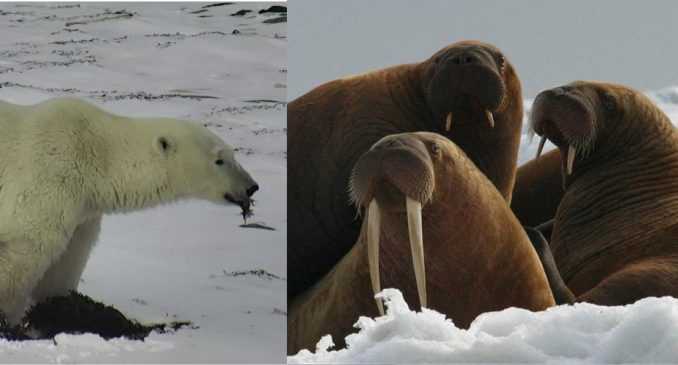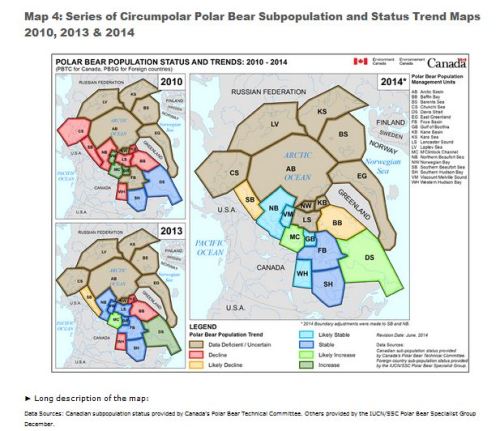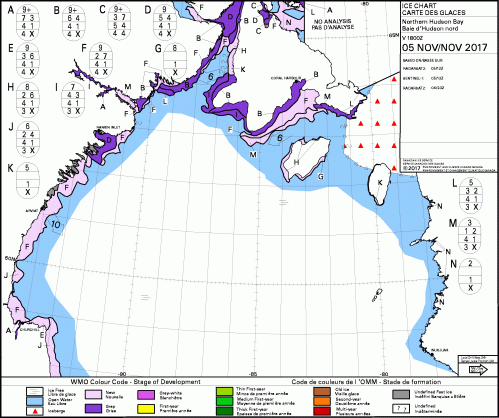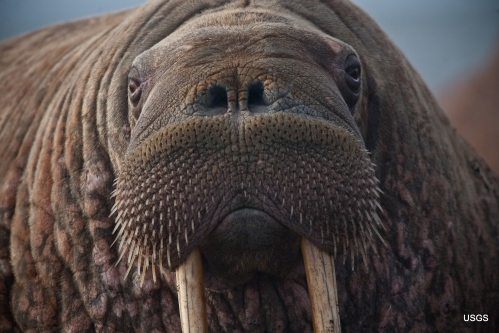
THE climate-obsessed mainstream media, continuing to brainwash their audience into belief by deception and scientific fraud.
“Lies” might be a better word to characterize the misinformation that scientists and the media have been busy spreading to the public over the last few weeks. The information is either known to be false (by scientists whose job it is to relay facts honestly) or is easily shown to be false (by journalists whose job it is to fact-check their stories).
POLAR BEAR MISINFORMATION
Earlier this month, biologist Nick Lunn was interviewed by the CBC and for the news program The National. He stated outright, without qualification, that Western Hudson Bay polar bear numbers have dropped from about 1200 (in 1987) to about 800 now (a 33% decline).
However, it is not scientifically appropriate to compare these figures because they were based on different types of surveys conducted over different portions of the region (they are also statistically insignificant). Lunn should know better because the published reports (Dyck et al. 2017; Stapleton et al. 2014; Lunn et al. 2016) make it clear these numbers are not comparable.
The official Western Hudson Bay estimate accepted by the PBSG in 2014, and by the IUCN in 2015, is 1030 bears (range 754-1406), based on the survey conducted by Stapleton and colleagues in 2011. Environment Canada considered the subpopulation ‘likely stable’ in 2014, an assessment upheld by the 2016 survey.

Because even the 2011 and 2016 Western Hudson Bay aerial surveys used somewhat different methods, the only population size numbers (subsets of each total) that can be compared are these:
2011 (949, range 618-1280)
2016 (842, range 562-1121)
The slight apparent decline over 5 years (11%) was not statistically significant (Dyck et al. 2017, pg. 3, 37) and is therefore equivalent to no change.
Similarly, when differences in methodology and statistical significance are taken into account, the estimate for 2016 cannot be said to be different from the 2011 estimate of 1030 bears (Stapleton et al. 2014), which was not statistically different from the estimate of 935 (range 794-1076) calculated in 2004 (Regehr et al. 2007).
‘Likely stable’ is probably the best way to characterize this result.
However, biologist Andrew Derocher has also been guilty of misrepresenting the facts on the Western Hudson Bay population status over the last few weeks:
Western Hudson Bay #polarbears decline >30% & Nunavut increases harvest quota. "almost impossible, to recommend" says Wildlife Director. pic.twitter.com/ogdqZ14HhW
— Andrew Derocher (@AEDerocher) November 3, 2017
And…
Aerial surveys ==> large confidence intervals & we'd need > 50% decline for statistical significance. Not precautionary management to wait https://t.co/cMw61Rwg71
— Andrew Derocher (@AEDerocher) September 14, 2017
And…
Western Hudson Bay #polarbear population dropped from 1030 bears to 842 over 2011-2016. 18% decline. Not "slight". https://t.co/AoVSqWSQjw pic.twitter.com/tmlgYlZ3a1
— Andrew Derocher (@AEDerocher) September 14, 2017
Bottom line: The 2011 estimate of 1030 cannot be compared to the 2016 estimate of 842 (or to the 1987 estimate of 1200) because these numbers were generated using different methods. Lunn and Derocher know this: it’s their job to know. But it’s their job to honestly relay scientific facts to the public, not an interpretation of those facts they’d prefer to be true.
Ironically, all this hype is being promoted as Hudson Bay seems gearing up for the earliest freeze-up in decades (here, here, and here).
In the chart below, grey ice (dark purple) is thick enough for an adult male polar bear to walk on. The new ice could still get blown out into the bay if the wind is right (from the south) but that does not seem likely under conditions of freezing cold temperatures, snow, and west and northwest winds at Churchill (for 5-8 November).

WALRUS MISINFORMATION

Here is Christopher Booker (The Telegraph, 4 November 2017) on the walrus nonsense being told by the BBC via its news body and its documentary series, “Blue Planet II”.
“…the BBC yet again [claimed] that Arctic ice is rapidly vanishing, supported on BBC News by a clip from David Attenborough’s Blue Planet II series, intoning that, among species most “seriously affected” by global warming, are walruses, showing hundreds of them desperately squeezing on to a melting ice floe.
But there are one or two little problems with this BBC version of the facts. First, far from Arctic ice vanishing, there has been no further downward trend in the extent of its summer melting since 2006. Its lowest point this September was higher than in seven of the past 11 years.
The US Fish and Wildlife Service has found that there are so many more of them than there were 30 years ago that last month that it decided not to list Pacific walruses on its endangered species list.
Secondly, far from walruses being “seriously affected”, an exhaustive survey by the US Fish and Wildlife Service has found that there are so many more of them than there were 30 years ago that last month that it decided not to list Pacific walruses on its endangered species list.
Thirdly, what produced that 2016 spike in CO2 and global temperatures was not “human activity” but the unusual warming of the Pacific Ocean by an abnormally strong El Niño. It is this warming that causes the oceans to “outgas” more CO2, not the CO2 that causes the warming: as even the BBC was told when, in July last year, its website quoted the Met Office under the heading “El Niño likely to boost CO2 in 2016”.
Since that El Niño ended, however, the latest Met Office data show that ocean temperatures have dropped sharply, with global surface temperatures back to where they were in 2002. Which is why the BBC’s reporting of all this last week could scarcely have been a better example of what it likes to scorn as “fake news”.
I couldn’t have said it better myself, except to add that Atlantic walrus, which the Blue Planet II folks filmed for their documentary, also show no evidence of being negatively impacted by climate change or sea ice loss so far.
Such disgraceful journalist practice is no better than the reaction of the CBC Radio here in Canada last month (4 October) to the news that the USFWS would not list walrus as ‘threatened.’
Instead of getting a scientist on to explain to listeners the science backing the decision, it had a spokesperson from the litigious Centre for Biological Diversity advocacy organization on the show to present a boring and quite predictable rant about why she disagreed with the decision. Of course she’s disappointed: she authored the document that forced the USFWS to consider the listing!
Bottom line: Have journalists forgotten how to do their jobs or do they really believe their opinions on certain subjects give them free license to ignore the ethics of their profession?
Actually, I could ask the same question about the polar bear specialists.
REFERENCES
Dyck, M., Campbell, M., Lee, D., Boulanger, J. and Hedman, D. 2017. 2016 Aerial survey of the Western Hudson Bay polar bear subpopulation. Final report, Nunavut Department of Environment, Wildlife Research Section, Iglolik, NU. http://www.gov.nu.ca/environnement/information/wildlife-research-reports#polarbear
Lunn, N.J., Servanty, S., Regehr, E.V., Converse, S.J., Richardson, E. and Stirling, I. 2016. Demography of an apex predator at the edge of its range – impacts of changing sea ice on polar bears in Hudson Bay. Ecological Applications, in press. DOI: 10.1890/15-1256
Regehr, E.V., Lunn, N.J., Amstrup, S.C. and Stirling, I. 2007. Effects of earlier sea ice breakup on survival and population size of polar bears in Western Hudson Bay. Journal of Wildlife Management 71:2673-2683.
Stapleton S., Atkinson, S., Hedman, D., and Garshelis, D. 2014.Revisiting Western Hudson Bay: using aerial surveys to update polar bear abundance in a sentinel population. Biological Conservation 170:38-47. http://www.sciencedirect.com/science/article/pii/S0006320713004618#
Ref.: https://polarbearscience.com/2017/11/05/scientists-and-media-continue-to-spread-misinformation-about-polar-bears-walrus/
Same story in LOPDKT
Fake news! How the BBC and Blue Planet got it wrong, yet again, about walruses and climate change
By Paul Homewood
Booker kills two BBC birds with one stone!

The BBC got excited about two things last week. One was that topping the list of new words entering this year’s dictionaries is “fake news”. The other was that, thanks to “human activities” and an El Niño weather event, 2016 saw a record spike in global CO2, taking it up to levels not seen since the Pliocene period “three to five million years” ago, when the world was “two to three degrees warmer” than today, and sea levels up to “20 metres” (66ft) higher thanks to melting polar ice.
This enabled the BBC yet again to claim that Arctic ice is rapidly vanishing, supported on BBC News by a clip from David Attenborough’s Blue Planet II series, intoning that, among species most “seriously affected” by global warming, are walruses, showing hundreds of them desperately squeezing on to a melting ice floe.
But there are one or two little problems with this BBC version of the facts. First, far from Arctic ice vanishing, there has been no further downward trend in the extent of its summer melting since 2006. Its lowest point this September was higher than in seven of the past 11 years.
The US Fish and Wildlife Service has found that there are so many more of them than there were 30 years ago that last month that it decided not to list Pacific walruses on its endangered species list
Secondly, far from walruses being “seriously affected”, an exhaustive survey by the US Fish and Wildlife Service has found that there are so many more of them than there were 30 years ago that last month that it decided not to list Pacific walruses on its endangered species list.
Thirdly, what produced that 2016 spike in CO2 and global temperatures was not “human activity” but the unusual warming of the Pacific Ocean by an abnormally strong El Niño. It is this warming that causes the oceans to “outgas” more CO2, not the CO2 that causes the warming: as even the BBC was told when, in July last year, its website quoted the Met Office under the heading “El Niño likely to boost CO2 in 2016”.
Since that El Niño ended, however, the latest Met Office data show that ocean temperatures have dropped sharply, with global surface temperatures back to where they were in 2002. Which is why the BBC’s reporting of all this last week could scarcely have been a better example of what it likes to scorn as “fake news”.


